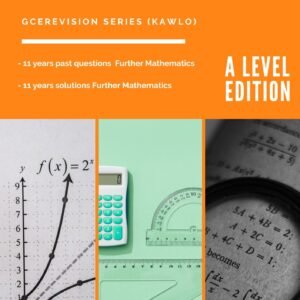To DOWNLOAD CAMEROON GCE JUNE 2009 math meach Paper 2 click on the link below
June 2009
1. The position vector of two particles A and B at time t seconds are r1 and r2 respectively, where
r1= [(5t2 + 35 t)i + (t2 — 2 )j]m
r2 = [(t3 + 3t2)i + (612 + 5 )j]m
(a) Show that the two particles will collide, stating the position vector of the point of collision.
(b) Obtain the velocity and acceleration vectors of each particle just before the collision and determine the particle which will be moving faster at that time.
2. (i) Forces F1,F2 and F3 act at point with position vectors r1, r2 and r3 respectively,
Where
Ft = (3i + 5j)N, F2 = (2i – 4j)N, F3 = (-Si -j)N
r1 = (i -j)m, r2 = (2i + j)m, r3 = (-6i +y)m
Show that this system of forces form a couple, giving the magnitude of the couple.
(ii) A uniform ladder of length 8m rest with it upper end against a smooth vertical wall and its lower end against a rough horizontal flour. The coefficient of friction between the ladder and the floor is ¾ and the angle between the ladder and the floor is 45°. A builder whose weight is twice that of the ladder, slowly climbs up the ladder. Find how far up the ladder he will climb before it begins slipping.
3. A particle of mass 3Kg, moving in a straight line with speed vms-1 at time t seconds is subject to a
retarding force of magnitude (u + 3v)N, where u is a positive constant. The particle starts from origin with speed 4u ms-1. Find in terms of u,
(a) the value of t when v = 2u.
(b) The distance x, of the particle from the origins, when v = 2u.
4. Two projectiles P and Q are fired from the same point 0 on the ground and at the same time, with their
velocities in the same vertical plane. The horizontal and vertical components of the velocities of P are 2u
and 3u ?ns_1 respectively,
(a) Find the ratio of the maximum height attained by P to the maximum height attained by Q.
(b) Show that the two projectiles strike the ground at the same spot on the horizontal plane through 0.
(c) Find the speed of the particle P, its horizontal distance from O, and its height above the horizontal
plane through 0 at the time Q strikes the ground, giving your answers in terms of u an g.

Two particles of mass 3Kg and M Kg (M < 3), rest on the smooth incline faces of a fixed wedge as shown in diagram. They are connected by a light inextensible string passing over a smooth pulley, fixed at the top of the wedge. The faces of the wedge are inclined at an angle θ to the horizontal, where sin θ=3/5
The particle are released from rest when both part of the string are taut. After traveling a distance of 1█(@2)/█(3@)
the speed of the particle is 27ms-1. Calculate
The acceleration of the particles,
The tension in the string,
The value of M
The magnitude and direction of the reaction of the pulley.
(ii) A particle of mass 2 kg is attach to one end B of a light inextensible string AB of length 0.2m. The other enf A of the string is fixed. The particle moves with constant angular speed in a horizontal circle of radius 0.3m whose centre 0 is vertically below A. Calculate.
(Take g as 10ms–1)
6. Three smooth spheres A, B and C of mass m, 2m and 3m respectively lie on a smooth horizontal floor with their centers in a straight line. Sphere A is projected with speed 3u and strikes sphere B directly. Sphere B subsequently collides directly with sphere C. Given that the coefficient of restitution between any two spheres during impact is ¼ . Find
The velocities of the spheres after the collision,
The impulse exerted by spheres A and- B due to impact
The Lost in KE due to impact between spheres B and C.
7. A car of mass 2000 kg is moving with a uniform speed on a level road against a constant frictional resistance of 5000N. Given that the engine of the car is working at a rate of 60kW, find
The speed of the car,
The work done by the engine in 3 seconds.
The car now start to ascend a slope inclined at an angle θ to the horizontal, sin θ = 0.1, with the engine working at the same rate and the frictional resistance remaining the same. When the car attains a stead’, speed of v ms-1, the engine is shut off.
The value of v,
The further distance covered by the car before coming to rest.
(take g as 10ms~2)
8. (i) Two independent events, A and B, are such that P(A) = 2/7 and P(A n B) = 1/5 . Find
P(B),
P(A U B).
(ii) A bag contains 1 red ball and 2 white balls. A trial consist of drawing a ball at random from the bag, noting its color and putting it back into the bag, together with an additional ball of the same color. Given that two trials are made, draw a tree diagram illustrating all the possible outcomes and the corresponding probabilities. Hence or otherwise, find the probability that
At least one red ball is drawn,
A red ball and a white ball are drawn.
Given that the two balls drawn are of the same color, find the probability that they are white.















